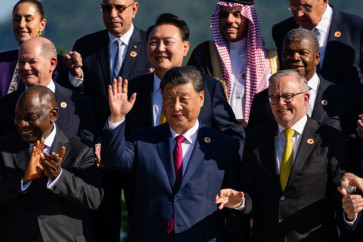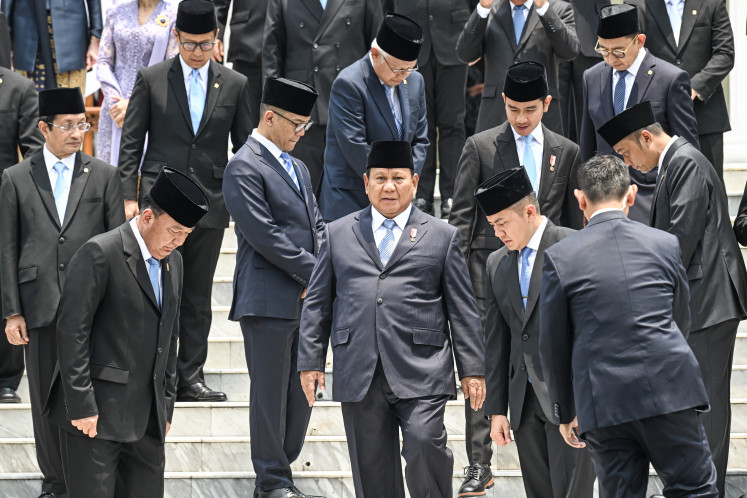Popular Reads
Top Results
Can't find what you're looking for?
View all search resultsPopular Reads
Top Results
Can't find what you're looking for?
View all search resultsFrom Romania with love
With more than 45 years of artistic endeavors under her belt, Romanian artist Elena Surdu Stanescu decides to play with universal symbols of love, affection and spirituality for her Jakarta exhibition
Change text size
Gift Premium Articles
to Anyone
W
ith more than 45 years of artistic endeavors under her belt, Romanian artist Elena Surdu Stanescu decides to play with universal symbols of love, affection and spirituality for her Jakarta exhibition.
The artist's works have been displayed in major galleries in Romania and abroad - from Asia to North America - but this is her first exhibition in Jakarta, and in Southeast Asia.
A series of torsos of man and woman in deep love and affection titled Couple, a series of torsos titled Beach and a series of graphics titled Birds, as well as bird sculptures, and windows with curtains are on display at the exhibition titled "Soul & Light", and have been brought all the way from Bucharest, Romania.
Like most of her works, the recurring motifs in Stanescu's pieces at the exhibition, held in cooperation between the Romanian Embassy and the French Cultural Centre, are human emotions.
"My works deal with life and love," she says, pointing to sculptures depicting couples in various moods.
Stanescu plays with universal symbols of love, affection and spirituality through the form and material of her works.
Her use of birds symbolizes the departure from the real world into a spiritual dimension; windows also symbolize communication or transcending to another dimension, while man and woman symbolize love.
"Nudity is a universal symbol of beauty; birds are general symbols of departure throughout the whole history of art. Birds are also symbols of silence and purity," Elena says, citing Pablo Picasso's Dove of Peace as an example.
"Woman and man are natural representations of love. It's easy to observe, which makes my art more accessible. Audiences will easily realize men and women mean love. Of course, there are other symbols of love but you can't make it any more obvious than men and women.
"If we symbolized love with man and man that would not necessarily be a symbol of love. It could be a symbol of sexual freedom, or of human rights, but it would not focus on love as a general symbol and as a normal way of perpetuating the species."
Stanescu's human figures never have complete bodies. The removal of some volume in sculpture is influenced by Greek sculptural elements.
"In sculpture, you talk of volume. The cutting off of some volume also represents a detachment from the real world. The idea is that the body is not eternal but the emotions are eternal. That's why you can easily cut some part of it. It doesn't matter, it will disappear anyway, but the sentiment will always be there. It sends the message that they don't have to look at the body to understand the soul, to understand what is behind it."
Stanescu emphasized that dimension of spirituality has been missing from the cheap, commercial presentation of art.
"Apparently some works of our contemporary artists tend to circle the same idea of sex. While they present embraces, the author endows it with an interpretation that does not deny sensuality but orientates toward tenderness, and to spiritual living," she says, quoting a well known Romanian artist and art critic, Adina Nano.
In some of her Couple torsos, Stanescu used silver as the material for man, symbolizing moonlight and creation, while using bronze as the material for woman, symbolizing warmth and life.
While mixed materials have their own meaning for the sculptures, Stanescu has always included what she refers to as "graphics" in her exhibition. Stanescu feels sculptures and graphics perfectly complement each other. She says graphics should be included because they are part of the process.
"It is the beginning of an idea. It's very difficult for me to separate them as art works. I always make a sculpture by referring to a graphic," she explains.
Like in many of her works, Stanescu's collection of the Couple torsos has a strong connection to her personal life. Since her husband died of illness at the age of 75, four years ago, she mostly creates human figures in couples.
"He was the love of my life and our 54 years of marriage were the best years of my life," Stanescu recalls.
Stanescu's artworks are not only a self-expression but also have taught her about life. Art has become a spiritual process for her, as deep as the commitment she brings to it. All her experiences feed her art.
"Soul and Light"










